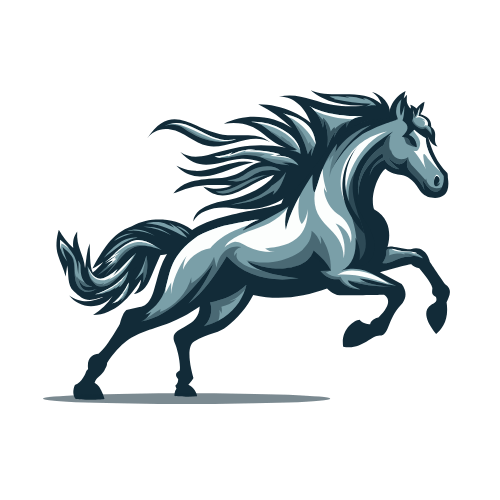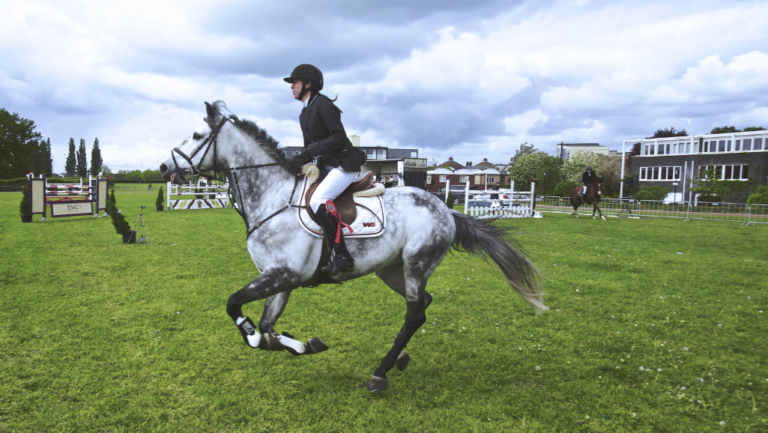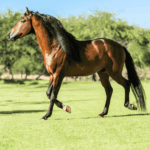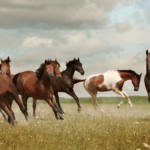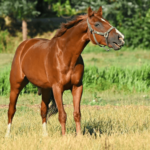Horses are majestic creatures known for their elegance and speed. Their unique gaits play a key role in their natural movement and in equestrian sports. From the leisurely walk to the exhilarating gallop, each gait has its own distinct pattern and purpose. Understanding these gaits is essential for any horse enthusiast or rider looking to enhance their horseback riding skills and deepen their connection with their equine partner.
In the 1870s, British photographer Eadweard Muybridge revolutionized our understanding of equine movement. He captured the different horse gaits in a series of photographs. This groundbreaking work revealed the intricate leg patterns and sequences that define each gait, from the symmetrical four-beat walk to the asymmetrical cantering and galloping.
As we delve into the world of horse gaits, we will explore the characteristics, benefits, and training techniques associated with each gait. We will also look at the unique gaits exhibited by specific horse breeds. By the end of this article, you will have a comprehensive understanding of how horses move and how to optimize their performance through targeted training and exercises.
Key Takeaways
- Horses have four basic gaits: walk, trot, canter, and gallop, each with a distinct pattern and speed.
- Cantering and galloping are asymmetrical gaits, with the canter being a three-beat gait and the gallop a four-beat gait.
- Proper training and conditioning are essential for horses to perform gaits correctly and maintain their health.
- Certain horse breeds, such as the Paso Fino and Icelandic Horse, exhibit unique gaits that set them apart from other breeds.
- Understanding horse gaits is crucial for riders to communicate effectively with their horses and excel in various equestrian disciplines.
Introduction to Horse Gaits
Knowing about horse gaits is key for anyone who loves horses or works with them. Horses move in many ways, each with its own purpose. Common gaits include walking, trotting, cantering, and galloping. Some horses also do ambling gaits like the running walk and foxtrot, which are smoother.
Gaits are divided into natural and ambling types. Natural gaits are what most horses do naturally. Ambling gaits, like the running walk, are smoother and need training. There’s also a way to classify gaits into walking, trotting, and leaping.
| Gait | Beats | Description | Breeds Capable |
|---|---|---|---|
| Walk | Four-beat | Slowest gait, legs never leave the ground entirely | 80% of all horse breeds |
| Trot | Two-beat | Diagonal gait, characteristic of warhorse breeds | 70% of horse breeds |
| Canter | Three-beat | Falling between a trot and a gallop | 50% of horse breeds |
| Gallop | Four-beat | Fastest gait, all four feet leave the ground | 30% of horse breeds |
Eadweard Muybridge changed how we see horse gaits in the 1870s. His photos showed how horses move, ending the myth of them flying. His work helped us understand horse movement better.
Gaits are typically categorized into two groups: the “natural” gaits that most horses will use without special training, and the “ambling” gaits that are various smooth-riding, four-beat footfall patterns that may appear naturally in some individuals.
Exploring horse gaits reveals their unique qualities and benefits. You’ll learn about training and exercises to improve gait quality. Understanding horse movement helps keep your horse healthy and performing well.
The Walk: A Four-Beat Gait
The horse walk is a natural, four-beat gait that serves as the foundation for all other gaits. In this gait, each of the horse’s hooves strikes the ground independently in a specific sequence, creating a distinct rhythm. The pattern of the walk typically follows the order of left hind, left front, right hind, and right front, with a brief moment of suspension between each step.
During the walk, the horse maintains a steady, even tempo, making it a comfortable and relaxing gait for both horse and rider. The four-beat rhythm allows the horse to move efficiently and cover ground at a moderate pace, usually around 4 miles per hour (6.4 kilometers per hour).
Variations of the Walk
While the basic four-beat gait remains consistent, there are several variations of the walk that horses may exhibit:
- Collected Walk: A shorter, more elevated stride with increased engagement of the hindquarters.
- Medium Walk: A balanced, active walk with a moderate length of stride and tempo.
- Extended Walk: A longer, more ground-covering stride while maintaining the four-beat rhythm.
- Free Walk: A relaxed, stretching walk that allows the horse to lower its head and neck.
Each variation of the walk serves a specific purpose in training, conditioning, and overall horse development. Riders and trainers utilize these variations to improve a horse’s balance, suppleness, and responsiveness.
Benefits of the Walk for Horses
The walk offers numerous benefits for horses, both physically and mentally:
- Improved Circulation: The gentle, rhythmic motion of the walk promotes blood flow and helps maintain healthy circulation throughout the horse’s body.
- Muscle Conditioning: Walking exercises and strengthens the horse’s muscles, particularly in the back, hindquarters, and abdominal region.
- Joint Health: The low-impact nature of the walk helps lubricate joints and maintains their flexibility, reducing the risk of stiffness and injury.
- Mental Relaxation: The steady, repetitive rhythm of the walk can have a calming effect on horses, helping them relax and release tension.
| Gait | Beats | Sequence | Speed (mph) |
|---|---|---|---|
| Walk | Four | Left Hind, Left Front, Right Hind, Right Front | 4 |
| Trot | Two | Diagonal Pairs: Left Hind + Right Front, Right Hind + Left Front | 8-12 |
| Canter | Three | Outside Hind, Diagonal Pair (Outside Front + Inside Hind), Inside Front | 10-17 |
| Gallop | Four | Hind Legs, Diagonal Pair (Hind + Front), Opposite Front, Leading Front | 25-30 |
Incorporating regular walks into a horse’s training regimen and daily routine is essential for maintaining their overall health, soundness, and well-being. By understanding the mechanics and benefits of the horse walk, riders and trainers can optimize their horse’s performance and longevity in any discipline.
The Trot: A Two-Beat Diagonal Gait
The horse trot is a two-beat diagonal gait. The horse moves its legs in unison, with diagonal pairs striking the ground together. This gait is stable, as the horse balances well without big head and neck movements.
The trot’s average speed is about 13 kilometers per hour (8.1 mph). Standardbred horses in harness racing can trot faster than a non-racehorse’s gallop. The North American speed record for a racing trot under saddle was 48.68 kilometers per hour (30.25 mph).
Horses in good shape can trot for a long time. It’s their main way to quickly move from one place to another. The British Horse Society dressage rules require six forms of the trot, showing its importance in equestrian disciplines.
Sitting Trot vs. Posting Trot
At speeds above a jog, the horse’s body drops and bounces up. This makes sitting the trot hard for riders. Most English riders post to the trot, rising and falling with the horse’s movement.
In contrast, the sitting trot requires riders to stay seated. They absorb the horse’s motion through their seat and core muscles.
Collected Trot and Extended Trot
The trot can be done at different speeds and lengths. The collected trot has shorter, more elevated strides. The horse keeps a rounded frame and engages its hindquarters more.
This trot is seen in dressage and requires balance and control. The extended trot has longer strides, with the horse reaching forward and extending its frame. It shows the horse’s natural athleticism and is seen in dressage tests and exhibitions.
| Gait | Beats | Average Speed |
|---|---|---|
| Walk | 4 | 3-4 mph |
| Trot | 2 | 8.1 mph |
| Canter | 3 | 10-17 mph |
| Gallop | 4 | 25-30 mph |
The Canter: A Three-Beat Gait
The canter is a fast, three-beat gait. It’s quicker than a trot but slower than a gallop. A horse canter’s speed is between 12 to 15 miles per hour. This speed depends on the horse’s stride length.
In the canter, one rear leg pushes the horse forward. This is matched by a longer foreleg on the same side.
Canter Leads: Right Lead vs. Left Lead
The canter lead shows which leg hits the ground first. In a right lead canter, the right hind leg goes first. Then, the left hind and right front legs hit together, followed by the left front.
The left lead canter is the opposite. Riders tell the horse which lead to take when starting the canter.
Collected Canter and Extended Canter
The collected canter is shorter and more compact. The horse stays balanced and looks like it’s going uphill. This version is used in dressage and precise riding.
The extended canter has longer strides. It shows the horse’s athleticism and ability to cover ground.
Counter-Canter and Flying Lead Changes
Counter-cantering happens when a horse canters on the outside lead on a circle. It improves balance and straightness. It also engages the hindquarters well.
Flying lead changes are when a horse switches leads without stopping. This requires coordination and clear communication between horse and rider.
| Gait | Average Speed (km/h) | Beats per Stride |
|---|---|---|
| Walk | 6.4 | 4 |
| Trot/Jog | 13-19 | 2 |
| Canter/Lope | 19-24 | 3 |
| Gallop | 40-48 | 4 |
Learning the canter is key for riders in many equestrian areas. Understanding this gait and practicing different canter styles helps both horse and rider. They can improve their partnership, balance, and athleticism.
The Gallop The Fastest Gait
The horse gallop is the fastest gait a horse can do. It reaches speeds that show off their power and agility. This gait is a four-beat rhythm with a moment of suspension where all legs are off the ground.
Horses can gallop at speeds from 40 to 48 kilometers per hour. Some breeds, like the American Quarter Horse, can go up to 55 miles per hour over short distances.
Types of Gallop: Hand Gallop and Full Gallop
The gallop has two types: the hand gallop and the full gallop. The hand gallop is a controlled version, allowing riders to keep a balanced speed. The full gallop is an all-out effort, reaching the horse’s maximum speed.
During a gallop, the sequence of footfalls is as follows:
- One hind leg strikes the ground first
- The other hind leg and opposite front leg strike together
- The remaining front leg strikes alone
- The horse pushes off, having all four legs suspended in the air momentarily before repeating the cycle
Galloping in Horse Racing
The gallop is used in horse racing, testing speed and endurance. Thoroughbreds are known for their speed and stamina. In 2008, a Thoroughbred set a record by maintaining an average speed of 43.97 miles per hour over a two-furlong distance.
Horses can reach thrilling speeds when galloping. But they can’t keep this pace for long. Most horses can only gallop for 1.5 to 3 kilometers before needing to rest.
| Gait | Average Speed (mph) | Average Speed (km/h) |
|---|---|---|
| Walk | 4 | 6.4 |
| Trot | 8-12 | 12.9-19.3 |
| Canter | 12-15 | 19.3-24.1 |
| Gallop | 25-30 | 40.2-48.3 |
| Racing Gallop (Thoroughbred) | 40-44 | 64.4-70.8 |
| Racing Gallop (Quarter Horse) | Up to 55 | Up to 88.5 |
Understanding the gallop and its types is key for riders and horse lovers. It helps us appreciate the incredible athleticism of horses. It also ensures their well-being in the exciting world of galloping and racing.
Cantering and Galloping Horse Gaits Explained
Cantering and galloping are two horse gaits with unique features. Knowing the difference helps riders communicate better with their horses. It also helps choose the right gait for different riding situations.
Differences Between Cantering and Galloping
The main difference is in the number of beats and footfall sequence. The canter has three beats, while the gallop has four with a pause. In the canter, the right lead’s sequence is left hind, right hind, and left front together, then right front. For the left lead, it’s right hind, left hind, and right front together, then left front.
The gallop’s sequence for the right lead is left hind, right hind, left front, and right front. For the left lead, it’s right hind, left hind, right front, and left front. The gallop is like the canter but with a pause between the diagonal legs.
Speed is another difference. The canter is slower, averaging 16–27 km/h (10–17 mph). The gallop is faster, averaging 40 to 48 kilometres per hour (25 to 30 mph). A study in the Journal of Equine Veterinary Science showed how the canter affects muscle activation and movement.
| Gait | Number of Beats | Footfall Sequence (Right Lead) | Footfall Sequence (Left Lead) | Average Speed |
|---|---|---|---|---|
| Canter | Three | LH, RH/LF, RF | RH, LH/RF, LF | 16–27 km/h (10–17 mph) |
| Gallop | Four | LH, RH, LF, RF | RH, LH, RF, LF | 40–48 km/h (25–30 mph) |
When to Use Cantering vs. Galloping
Cantering is great for training, trail riding, and equestrian sports like dressage and show jumping. It’s good for precise maneuvers and covering long distances at a moderate pace. It also helps in better communication between the horse and rider.
Galloping is best for racing and cross-country riding, where speed and endurance matter. It’s fast and efficient for covering ground, but horses can only gallop for short times before needing rest.
Choosing between cantering and galloping depends on the horse’s fitness, the terrain, and the ride’s purpose. It’s important to condition horses gradually and always prioritize their well-being and safety.
Gaited Horse Breeds and Their Unique Gaits
Most horse breeds have three basic gaits: walk, trot, and canter or gallop. But gaited horse breeds have special gaits that make riding smoother and more comfortable. These horses are sturdy, easy to handle, and don’t need much care. About 30 out of 350 horse breeds are naturally gaited, making them rare and sought-after.
Gaited horses are great for people with back or joint problems because they offer a smoother ride. They can go up to 14 to 15 km/h in their unique gait. This is more comfortable than the trot, which can be bumpy.
The special gait in some breeds comes from a genetic mutation. Training can make these gaits even better, making long rides more enjoyable.
Paso Fino and the Paso Gait
The Paso Fino comes from Puerto Rico and Colombia. It’s known for its smooth, four-beat lateral ambling gait called the paso gait. Paso Finos are 13 to 15 hands tall and weigh 700 to 1,100 pounds.
They are known for their endurance and sure-footedness. This makes them perfect for trail riding and long trips.
Tennessee Walking Horse and the Running Walk
The Tennessee Walking Horse comes from the southern United States. It’s famous for its running walk, a four-beat gait where the hind feet overstep the front feet. This gait is smooth and comfortable for riders.
Tennessee Walking Horses are 14 to 17 hands tall and weigh 900 to 1,200 pounds. Their long limbs help them move fast in both the running walk and canter.
Icelandic Horse and the Tölt
The Icelandic Horse has stayed pure for over 1,000 years. It has two special gaits: the tölt and the flying pace. The tölt is a four-beat lateral ambling gait that’s smooth and comfortable, even at high speeds.
The flying pace is a two-beat lateral gait with a moment of suspension. Icelandic horses are 12 to 14 hands tall and weigh 730 to 840 pounds.
| Breed | Height (hands) | Weight (pounds) | Unique Gait |
|---|---|---|---|
| Paso Fino | 13-15 | 700-1,100 | Paso Gait |
| Tennessee Walking Horse | 14-17 | 900-1,200 | Running Walk |
| Icelandic Horse | 12-14 | 730-840 | Tölt, Flying Pace |
Other gaited horse breeds include the American Saddlebred, known for its rack; the Peruvian Paso, with its paso llano and sobreandando; and the Kentucky Mountain Saddle Horse, with its amble or rack. Gaited horse breeds are found worldwide but are less common than trotting horses. They are a unique and valuable part of the equestrian world.
Training Horses for Different Gaits
Learning various gaits is crucial for horses and riders. It boosts their versatility and performance in different areas. Horse gait training needs patience, consistency, and understanding the horse’s limits. Trainers and riders must work together to build a strong communication and a supportive learning space for the horse.
Exercises to Improve Gait Quality
Adding specific exercises to your horse’s training can greatly improve their gait quality. Some effective exercises include:
- Ground poles and cavaletti work to enhance balance, coordination, and stride length
- Hill work to build strength and engage the hindquarters
- Lateral work, such as leg yields and shoulder-in, to improve suppleness and responsiveness
- Transitions between gaits to refine communication and control
These exercises for gait quality should match your horse’s needs and get harder as they get better.
Transitioning Between Gaits
Smooth transitions between gaits show a well-trained horse and a skilled rider. Mastering transitions needs clear communication, precise timing, and understanding the biomechanics of each gait. When transitioning between gaits, riders must use their seat, legs, and hands in harmony to signal the desired change in speed and movement.
| Transition | Key Points |
|---|---|
| Walk to Trot | Maintain a steady rhythm, use a slight squeeze with the legs, and allow the horse to move forward |
| Trot to Canter | Sit deeply in the saddle, apply outside leg behind the girth, and use a half-halt to balance the horse before cueing for the canter |
| Canter to Trot | Use a half-halt to rebalance the horse, sit tall, and gently squeeze with both legs to encourage the trot transition |
| Trot to Walk | Gradually decrease the energy with half-halts, allow the horse to slow down, and maintain a steady contact with the bit |
Patience and consistency are key when training horses for different gaits. Celebrate small victories and always prioritize the horse’s well-being and confidence throughout the learning process.
By spending time and effort on horse gait training, focusing on exercises for gait quality and transitioning between gaits, riders and trainers can unlock their horse’s full potential. This leads to a more harmonious partnership in the saddle.
Common Gait Problems and Solutions
Horses can face many gait issues due to things like bad conformation, wrong training, or health problems. It’s important to spot these common horse gait problems to find the right solutions for gait issues. Some common issues include:
- Cross-firing: When a horse’s hind leg on one side moves with the front leg on the opposite side
- Overreaching: When the hind feet strike the front feet or legs during movement
- Forging: When the hind feet strike the back of the front feet
- Paddling: Excessive outward rotation of the front legs during movement
- Winging: Excessive inward rotation of the front legs during movement
To fix these gait problems, finding the root cause is key. A vet or equine expert can help with this. Solutions might include:
- Veterinary care: Fixing health issues like lameness or muscle problems
- Corrective farriery: Changing the horse’s hooves and shoes for better balance
- Tack adjustments: Making sure the saddle, bridle, and other gear fit right and don’t hurt
- Training modifications: Changing how you train to fix specific gait issues and improve movement
Watching a horse’s gait closely and fixing any problems quickly helps keep them healthy and performing well. Regular checks and talking to vets and farriers are vital for identifying gait abnormalities and finding good solutions for gait issues.
Preventing gait problems is better than treating them. Good training, regular exercise, and a balanced diet can help a lot.
| Gait Abnormality | Potential Causes | Solutions |
|---|---|---|
| Cross-firing | Poor conformation, weakness, or lack of coordination | Strengthening exercises, corrective shoeing |
| Overreaching | Long toe/low heel conformation, fatigue, or poor balance | Corrective trimming/shoeing, conditioning exercises |
| Forging | Improper hoof balance, fatigue, or riding errors | Corrective shoeing, improved fitness, rider education |
| Paddling | Conformational defects, poor hoof balance, or injury | Corrective shoeing, physical therapy, strengthening exercises |
| Winging | Conformational defects, poor hoof balance, or injury | Corrective shoeing, physical therapy, strengthening exercises |
The Importance of Understanding Horse Gaits
Knowing about horse gaits is key for horse owners and riders. It helps them work together better. By learning about different gaits, riders can improve their skills and move in sync with their horses.
Gaits and Horse Health
Understanding gaits can also spot health issues in horses. Changes in how a horse moves might mean they’re sick or hurt. Catching these signs early helps get the right care and keeps the horse healthy.
Here are some common health issues linked to horse gaits:
- Lameness: A change in gait due to pain or discomfort in the limbs or hooves
- Neurological disorders: Conditions affecting the nervous system, causing abnormal gait patterns
- Hoof problems: Issues such as abscesses, thrush, or imbalances in hoof trimming can alter gaits
- Musculoskeletal injuries: Strains, sprains, or tears in muscles, tendons, or ligaments can impact gait quality
Gaits in Equestrian Sports and Disciplines
In equestrian sports, gaits are very important. Each sport has its own rules for how horses should move. For example:
| Discipline | Key Gaits | Gait Requirements |
|---|---|---|
| Dressage | Walk, Trot, Canter | Rhythm, suppleness, engagement, collection |
| Reining | Gallop, Sliding Stop, Rollback | Precision, speed, agility |
| Show Jumping | Canter, Gallop | Rhythm, impulsion, straightness, adjustability |
| Endurance Riding | Trot, Canter, Gallop | Efficiency, stamina, soundness |
Knowing about gaits in each sport helps riders prepare better. This knowledge lets them show their horse’s skills well and do better in competitions.
“The study of gaits is essential for any equestrian, whether you’re a leisure rider or a competitive athlete. It forms the foundation of horsemanship and enables us to communicate effectively with our equine partners.” – Dr. Hilary Clayton, veterinarian and equine biomechanics expert
In conclusion, understanding horse gaits is crucial for their health, well-being, and performance in different sports. By learning more about gaits, we can build stronger bonds with our horses and do well in equestrian activities.
Conclusion
In this article, we’ve delved into the world of horse gaits. We’ve seen the natural gaits like walking, trotting, cantering, and galloping. We’ve also looked at the unique ambling gaits of certain breeds. Understanding gaits is key for horse owners, riders, and fans.
Knowing the unique traits of each gait helps us see the beauty and versatility of horses. Whether you’re an experienced rider or just starting, learning about gaits can improve your bond with your horse. It also boosts your performance in different riding areas.
As we wrap up our look at horse gaits, remember that learning and practice are crucial. By growing our knowledge of how horses move and train, we help them stay healthy and perform well. Let’s keep learning about gaits and enjoy the world of horses together.
